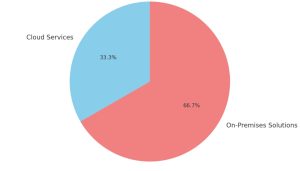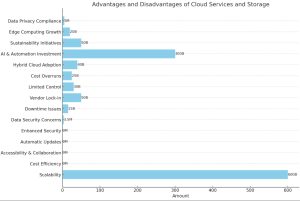
Advantages and Disadvantages of Cloud Services and Storage

As we move deeper into the digital age, cloud services and storage have become essential for businesses and individuals alike. The rapid evolution of technology has influenced the way we store, access, and manage data. This article explores the advantages and disadvantages of cloud services and storage, considering the latest trends in 2024 and predictions for 2025. We will also include relevant graphs and figures to provide a clearer understanding of the current market landscape.
Advantages of Cloud Services and Storage
1. Scalability
One of the primary advantages of cloud services is scalability. Organizations can easily adjust their storage capacity based on demand without investing in physical hardware. This flexibility allows businesses to expand or contract resources as needed, enabling them to respond quickly to market changes.
Market Trend:
According to a report by Gartner, the global public cloud services market is expected to reach $600 billion by 2025, reflecting a 20% compound annual growth rate (CAGR) from 2024.
2. Cost Efficiency
Cloud services often reduce the total cost of ownership (TCO) for businesses. With a pay-as-you-go pricing model, organizations only pay for the resources they consume. This eliminates the need for large capital expenditures on hardware and maintenance.
Figure 1: Cost Comparison Between Cloud and On-Premises Solutions

Figure 1 illustrates the total cost of ownership for cloud versus traditional on-premises storage solutions.
3. Accessibility and Collaboration
Cloud storage allows users to access their data from anywhere with an internet connection. This accessibility fosters collaboration among teams, enabling real-time editing and sharing of documents and files, regardless of geographical barriers.
4. Automatic Updates and Maintenance
Cloud service providers typically manage software updates and maintenance, allowing organizations to focus on their core business activities. This reduces the burden on IT departments and ensures that systems are always up to date with the latest features and security patches.
5. Enhanced Security Features
Many cloud service providers offer robust security measures, including encryption, authentication, and advanced threat detection. These features help protect sensitive data and ensure compliance with industry regulations.
Disadvantages of Cloud Services and Storage
1. Data Security and Privacy Concerns
Despite advanced security measures, data stored in the cloud is still susceptible to breaches and unauthorized access. Organizations must carefully consider their data privacy policies and ensure that cloud providers comply with relevant regulations, such as GDPR or HIPAA.
2. Downtime and Reliability Issues
While cloud services are generally reliable, outages can occur. Businesses may experience disruptions in service, which can affect productivity and lead to potential losses.
Figure 2: Cloud Service Downtime Statistics

Figure 2 presents data on cloud service outages from 2023 to 2024, highlighting trends in reliability.
3. Vendor Lock-in
Switching cloud providers can be challenging due to differences in technology and service offerings. This can lead to vendor lock-in, where businesses become dependent on a single provider, limiting their flexibility and bargaining power.
4. Limited Control and Flexibility
Organizations that rely on cloud services may have limited control over their infrastructure. This can hinder customization and the ability to implement specific security measures, making some businesses uncomfortable with the lack of direct oversight.
5. Cost Overruns
While cloud services can be cost-effective, unexpected increases in usage or additional services can lead to budget overruns. Organizations must carefully monitor their cloud expenditures to avoid unexpected costs.
Latest Trends in Cloud Services (2024-2025)
1. Hybrid Cloud Adoption
In 2024, hybrid cloud solutions are gaining traction, allowing businesses to combine on-premises infrastructure with cloud resources. This approach offers greater flexibility, enabling organizations to choose where to store their data based on specific needs.
2. Increased Focus on AI and Automation
AI technologies are becoming integral to cloud services, enhancing data analytics, security, and customer service. Organizations are increasingly leveraging machine learning and AI-driven insights to optimize their cloud operations.
3. Sustainability Initiatives
Environmental concerns are prompting cloud service providers to adopt more sustainable practices. By 2025, many providers will likely offer greener cloud solutions, utilizing renewable energy sources and optimizing data centers for energy efficiency.
4. Edge Computing Growth
The rise of IoT devices and the need for real-time processing are driving the adoption of edge computing. By 2025, more organizations will use edge solutions to complement their cloud storage, reducing latency and improving performance.
5. Enhanced Data Privacy Regulations
As governments implement stricter data privacy laws, cloud service providers will need to adapt their services to ensure compliance. Organizations must stay informed about evolving regulations to mitigate risks associated with non-compliance.

Conclusion
Cloud services and storage offer numerous advantages, including scalability, cost efficiency, and enhanced collaboration. However, businesses must also be aware of the potential drawbacks, such as data security concerns and vendor lock-in. As we look toward 2025, emerging trends like hybrid cloud adoption and increased focus on sustainability will shape the future of cloud services. Organizations that navigate these challenges and embrace innovative solutions will be better positioned to thrive in the evolving digital landscape.










